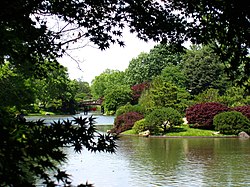Missouri Botanical Gardens
|
Missouri Botanical Garden
|
|

A view of Seiwa-en, the largest Japanese garden in North America
|
|
| Location | St. Louis, Missouri |
|---|---|
| Coordinates | 38°36′51″N 90°15′32″W / 38.6141°N 90.2589°WCoordinates: 38°36′51″N 90°15′32″W / 38.6141°N 90.2589°W |
| Built | 1859 |
| Architect | Multiple |
| Architectural style | Late Victorian |
| NRHP Reference # | 71001065 |
| Significant dates | |
| Added to NRHP | November 19, 1971 |
| Designated NHLD | December 8, 1976 |
The Missouri Botanical Garden is a botanical garden located at 4344 Shaw Boulevard in St. Louis, Missouri. It is also known informally as Shaw's Garden for founder and philanthropist Henry Shaw.
Founded in 1859, the Missouri Botanical Garden is one of the oldest botanical institutions in the United States and a National Historic Landmark., as well as the National Register of Historic Places. The Garden is a center for botanical research and science education of international repute, as well as an oasis in the city of St. Louis, with 79 acres (32 ha) of horticultural display. It includes a 14-acre (5.7 ha) Japanese strolling garden named Seiwa-en; the Climatron geodesic dome conservatory; a children's garden, including a pioneer village; a playground; a fountain area and a water locking system, somewhat similar to the locking system at the Panama Canal; an Osage camp; and Henry Shaw’s original 1850 estate home. It is adjacent to Tower Grove Park, another of Shaw’s legacies.
In 1983, the Botanical Garden was added as the fourth subdistrict of the Metropolitan Zoological Park and Museum District.
For part of 2006, the Missouri Botanical Garden featured "Glass in the Garden", with glass sculptures by Dale Chihuly placed throughout the garden. Four pieces were purchased to remain at the gardens. In 2008 sculptures of the French artist Niki de Saint Phalle were placed throughout the garden. In 2009, the 150th anniversary of the Garden was celebrated, including a floral clock display.
After 40 years of service to the Garden, Dr. Peter Raven retired from his presidential post on September 1, 2010. Dr. Peter Wyse Jackson replaced him as President.
...
Wikipedia



